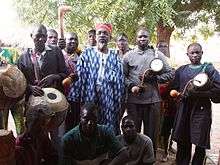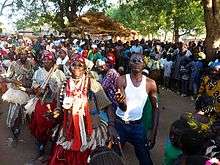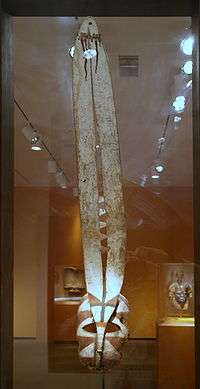Mossi people
 The fast-moving Mossi cavalry once dominated large areas of what is now Burkina Faso | |
| Total population | |
|---|---|
|
(6.2 million in Burkina Faso (40%) 1.2 million Cote d'Ivoire 160,140 in Ghana) | |
| Regions with significant populations | |
| Primarily Burkina Faso, populations also present in northern Cote d'Ivoire and northern Ghana. | |
| Languages | |
| Mòoré | |
| Religion | |
| Islam 65%, Christianity 15%, Traditional 20% | |
| Related ethnic groups | |
|
Mamprusi, Dagomba Gurunsi, Frafra, Talensi, Bwa, Nankani. Lobi, Dagaaba, other Gur peoples |
| Person | Moaaga |
|---|---|
| People | Mosse |
| Language | Mòoré |
The Mossi (or Mole, Mosse, sing. Moaaga) are a people in central Burkina Faso, living mostly in the villages of the Nazinon and Nakanbe (formerly Volta) River Basin. The Mossi are the largest ethnic group in Burkina Faso, constituting more than 40% of the population,[1] or about 6.2 million people. The other 60% of Burkina Faso's population is composed of more than 60 ethnic groups, mainly the Gurunsi, Senufo, Lobi, Bobo and Fulani.[2] The Mossi speak the Mòoré language.
History
Part of a series on the |
||||||||||||||
|---|---|---|---|---|---|---|---|---|---|---|---|---|---|---|
| History of Burkina Faso | ||||||||||||||
 | ||||||||||||||
|
||||||||||||||
|
||||||||||||||
|
| ||||||||||||||
The Mossi people originated in Burkina Faso, although significant numbers of Mossi live in neighboring countries, including Benin, Côte d'Ivoire, Ghana, Mali, and Togo. In 1996, the estimated population of Burkina Faso was 10,623,323. Five to six million are probably Mossi; another 1.2 million Mossi live in Côte d'Ivoire.
Legendary origins
According to tradition, the Mossi comes from the marriage of a Mamprusi princess and Mandé hunter.
Yennenga was a warrior princess, daughter of a Mamprusi king in upper east Ghana. While exploring her kingdom on horseback, she lost her way and was rescued by Rialé, a solitary Mandé hunter. They got married and gave birth to the first authentic Mossi, Ouedraogo, who is recognised as the father of Mossi people.
The Mossi are directly descended from the Mamprusi people and similarly live in upper east Ghana with a capital of Bawku/Nalerigu. These legendary origins apply only to the Nakomse, or the ruling class.
The Tengabisi and other Mossi peoples do not share these origin myths.
Mossi Kingdoms
As the Mossi people's history has been kept by oral tradition, it is impossible to assign precise dates for the period before colonization.[3] Nevertheless historians assign the beginning of their existence as a state to the 15th century. The Mossi were able to conquer a vast amounts of territory thanks to their mastering of the horse, created a prosperous empire, and kept peace in the region until the beginning of colonialism. The expansion of the Mossi empire was stopped in the 19th century with the initiation of intensive colonisation by the French.[2]
Colonial era
French rule affected Mossi society and weakened the power of the Mossi emperor, the Mogho Naaba. Despite colonization, the Mogho Naaba was given some authority over the Mossi during the French colonial period. He is consulted today for crucial decisions, especially those affecting the destiny of society. Two great events have affected the status of the Mogho Naaba during colonization:
- During the initial phase of the French invasion, he retired to the Dagomba kingdom with which the Mossi have always kept brotherly relations.
- In 1896, the Mogho accepted the French protectorate.
Though it has not been generally recognized, the Mossi played a key role in France's military during World War II. They constituted the greater part of the corps in the military troops of French West Africa, known in French as the Tirailleurs Sénégalais.[4]
Organization of Mossi society
The Mossi people have organised their society in an original hierarchic process in which family and state are the key elements.[2] The Mossi peoples are very heterogeneous. When horsemen invaded from the south they created a political or ruling class, called Nakomse, and a spiritual class called Tengabisi. All chiefs come from the ruling class. The Tengabisi include Saya, smiths, Nyonyose, farmers, Yarse, weavers and merchants, and others.
The origins of the Nyonyose are diverse: In the north their ancestors were Dogon and Kurumba, in the southwest their ancestors were Lela, Nuna, Sisala and others, and in the far east they were Gurmantche. These people were united into a new ethnicity called Mossi in about 1500.
It is a mistake to describe a "Nyonyosé tribe" or the "art of the Nyonyosé" because the Nyonyose do not exist outside Mossi society. All Nyonyosé are Mossi. At the same time, it is a mistake to assume that all segments of Mossi society are culturally identical, for the differences between the Nakomsé and the Tengabisi are striking; only the Tengabisi use masks, and only the Nakomsé use figures in the context of political celebrations. The Nakomse are the political class, and the Tengabisi are the spiritual class.
Mogho Naaba and the Nakomse
The highest position in Mossi society is that of the Emperor, who is given executive power. The Emperor's role is to rule the entire population and to protect the kingdom. Today, he lives in Ouagadougou, the historical and present capital of Burkina Faso. Though the political dynamic of the country has changed, the Mogho Naaba (Emperor) is recognised by his people and has substantial authority.

Second to the Emperor come the nobles: Nakomse. The Nakomse are all from the family of the Emperor, whether they be brothers, sisters, cousins, or otherwise. All dignitaries come from the Emperor's family. The Nakomse are often assigned territories in the kingdom as governorships and rule in the name of the Mogho Naaba. As in the past, the Emperor needs the support of his Nyon-nyonse (or gnon-gnon-sse) subjects to fully exercise his power. The Nyon-nyonse are the peoples who lived in Mossi-controlled regions before the Mossi.[5]
Mossi society is divided vertically into two major segments: the descendants of the horsemen who conquered the peoples on the Mossi plateau are called the Nakomse (“people of power”), and all Mossi chiefs come exclusively from the Nakomse class. These people use figures as political art to validate their rule over the peoples they conquered. The descendants of the ancient farming peoples who had occupied the land from the beginning of time and who, by right of first occupation, were and are the owners of the land are called the Tengabisi (“people of the earth”). These Tengabisi can be further divided into groups of smiths (Saya), groups of traders (Yarse) and, most important, groups of farmers (Nyonyose). Generally the smiths and the traders do not use masks, but the Nyonyose, the “ancient ones” are the principal makers and users of masks in Mossi society.
Craftsmen and ordinary citizens

They constitute the larger part of the population and are all subjects of the emperor. These two groups are generally fused but have internal subdivisions, each one having its own ruling family; they perform ceremonies and other important events. Mossi people often identify with groups; hence, at all levels, there is a hierarchy in Mossi society. In everyday life, the family hierarchy is most important, and family is often directly associated with the notion of hierarchy for the Mossi.
'Mogonaba' was what Leo Frobenius was told was the appropriate term for the emperor of Mossi at Wagadugu when he visited the country in 1904-6. His is one of the few disinterested reports as he was an anthropologist and not a missionary, representative of a European company, or military. He describes a court much like a European one (he may have an anti-aristocratic bias) with nobles in intrigues over commerce, power and industry. This report alone caused disbelief in Europe as no European source had ever considered Africans to be socially like Europeans. The lack of racism in Frobenius' report and his discovery of an industrious people and what some would describe as a glorious past interested W.E.B. Du Bois in Frobenious' other writings on Africa. Rudolf Blind's translation in English of the Voice of Africa, published by Hutchinson & Co., produced some racist comments he thought necessary to conform with English sensitivities — otherwise he believed no Englishman would consider the book realistic.
An important contribution was made in the 1960s by the historian Elliott P. Skinner, who wrote at length about the sophistication of Mossi political systems in The Mossi of the Upper Volta: The Political Development of a Sudanese People. This was at a time when many African countries were gaining independence, and Skinner strongly made the point that African peoples were very clearly qualified to govern themselves.[6]
Language and cultural values
Group identity and values within the Mossi and contrasted against other ethnic groups are tied first and foremost to language.
Mossi language
The Mossi speak the More language, of the Western Oti-Volta group of languages, northwestern sub-group. It is spoken in Burkina, Ghana, and Ivory Coast[7][8] This language group is part of a larger grouping, Gur languages belonging to the Niger–Congo family. In the language there are a few dialects based mainly on region. For example, there is a dialect spoken in Yatenga (Ouahigouya), another distinct dialect in the northern region, a third in the southeast in Koupela, different from a fourth dialect in the same region called Tenkodogo.[2] Despite these regional differences, the dialects are mutually intelligible.
Cultural values
According to the explanations of Tapsoba Marie, the former Cultural Counsellor at Burkina Embassy in Senegal and Mossi herself, Mossi culture can be divided into four main values characteristic of the ethnic group.[9]
Attitude towards ancestors
Ancestors are believed to have reached a better world from which they can influence life on earth. They can help or punish their descendants depending on their behavior. Ancestors are also the judges that have the power to allow a descendant to enter the "pantheon of the ancestors". If an ancestor chooses to deny entrance, the soul of the disavowed one is condemned to run at random for all eternity. Because of these beliefs, Mossi swear by their ancestors or by the land; when they do so (which only occurs in extreme situations), it is more than symbolic — it is a call to imminent justice.
Land
Land is related to the ancestors, being a path by which one can access the ancestors.[9] Even today, this notion gives a unique value to land in Mossi thought. Land is considered to be much more than simple dust and has a spiritual dimension to it. A Mossi's life depends on his/her land, and it is essential for the family settlement.
Family
Family is an essential cultural element of the Mossi, who hold collectivism in high regard.[9] Individualism does not exist in traditional Mossi culture: one’s actions and behaviors are always taken to be characteristics of one's family. They must always ask an elder in order to do something. As a result, all are expected to act in their family's name; thus, the family is the smallest entity in the Mossi society. Heritage is patrilineal, passed down from a father to his sons. However, when a man has no sons, women can inherit from their husbands and even from their father.
Hierarchy
Hierarchy is a fundamental concept for the Mossi and pervasive in their culture.[9] The family is organised like a kingdom with its king — the husband and father, his advisor — the wife, and the people — the children. Aunts and uncles play a role by helping in the education and raising of children.
Traditional and cultural holidays and events

Ceremonies and celebrations pace the life of Mossi people, with each celebration having its particulars. Through them the community expresses joy or suffering, or simply fulfills duties to the memory of the ancestors.
Mogho Naaba court
The Friday Mogho Naaba court ceremony derives from an event when the Moro Naba's sister fled north to the land of Yadega, the kingdom called Yatenga. As she fled north, she carried all of the amulets of power, or nam, with her. The Moro Naba had to decide whether to follow her and retrieve his sacred power objects or to remain behind to rule over his people. Three times he left his palace to mount a white horse, and three times he returned to the palace. In the end he did not pursue his sister, and to this day the kings of Yatenga claim that they hold the power of Mossi rule.
The political segment of Mossi society, the Nakomse, use art to validate their rule. Bridles, saddles, stirrups and other objects associated with the horse are very important. In addition, Mossi chiefs use carved wooden figures to represent their royal ancestors. These figures are displayed each year at royal festivals called na possum, when the heads of each household in the community reaffirm their allegiance and loyalty to the chief.[10]
Mossi Masks

The Nyonyose (the ancient farmers and spiritual segment of Mossi society) use masks in their religious observances and rituals. The Nakomse (chief class) do not use masks. Masks in initiations and funerals is typical of all the Voltaic or Gur-speaking peoples, including the Nyonyose, Lela, Winiama, Nouna, Bwaba, and Dogon. Masks appear at burials to observe on behalf of the ancestors that proper procedures are carried out. They appear at funeral or memorial services held at regular intervals over the few years after an elder has died. Masks attend to honor the deceased and to verify that the spirit of the deceased merits admission into the world of ancestors. Without a proper funeral, the spirit remains near the home and causes trouble for his/her descendants.
Masks are carved of the wood of the Ceiba pintandra, the faux kapokier. They are carved in three major styles that correspond to the styles of the ancient people who were conquered in 1500 by the invading Nakomse and integrated into a new Mossi society:
- In the north masks are vertical planks with a round concave or convex face.[11]
- In the southwest masks represent animals such as antelope, bush buffalo, and strange creatures, and are painted red, white and black.
- In the east, around Boulsa,[12] masks have tall posts above the face to which fiber is attached.
Female masks have two pairs of round mirrors for eyes; small masks, representing Yali, "the child," have two vertical horns. All Nyonyose masks are worn with thick costumes made of the fiber of the wild hemp, Hibiscus cannabinus, In the old days only the northern Nyonyose in Yatenga and Kaya, and the eastern people around Boulsa allowed their masks to be photographed. The people in the southwest forbade photography because it did not conform to the yaaba soore, the path of the ancestors.
Mask characters include Balinga, the Fulani woman; katre, the hyena; nyaka, the small antelope; Wan pelega, the large antelope, and many others. Masks from all three areas appear at annual public festivals such as SIAO (Fr. Salon international de l’Artisanat de Ouagadougou), Week of the Culture, and the Atypical Nights of Koudougou (Les Nuits Atypiques de Koudougou). Each Nyonyose family has its own mask, and they are charged with protecting the masks to this day. Masks are very sacred and are a link to the spirits of ancestors and of nature.
References
- ↑ "Burkina Faso". The World Factbook. Central Intelligence Agency. January 15, 2010. Retrieved February 11, 2010.
- 1 2 3 4 Roy, Christopher D. (August 18, 2006). "Burkina Faso". Art and Life in Africa Project. University of Iowa. Retrieved February 11, 2010.
- ↑ Burkina Faso (2006b). Sculptures de Laongo Burkina Faso Retrieved 04/12/ 2006 from
- ↑ "Aeroport de Ouagadougou...". Au Burkina Faso (in French). 2010. Retrieved December 4, 2006.
- ↑ Tauxier, Louis. Le Noir du Yatenga. Paris, Larose: 1917
- ↑ Skinner, Eliott P., The Mossi of the Upper Volta: The Political Development of a Sudanese People, Stanford, Stanford University Press
- ↑ Naden, Tony (1989). Gur. pp. 141–168.
- ↑ Bendor-Samuel [ed.], J.T. (1989). The Niger-Congo Languages. Lanham MD: University Press of America.
- 1 2 3 4 Tapsoba, Marie, interview on 04/03/2006. "Significant values of Mossi and Traditional and Cultural Events."
- ↑
- ↑ "Mask styles", University of Iowa
- ↑
External links
- Detailed description of Mossi masks (archived)
- Ouagadougu masks (archived)
Further reading
- Roy, Christopher D. Art of the Upper Volta Rivers. Meudon: Chaffin, 1987
- Roy, Christopher D. Land of the Flying Masks. Munich: Prestel, 2007.